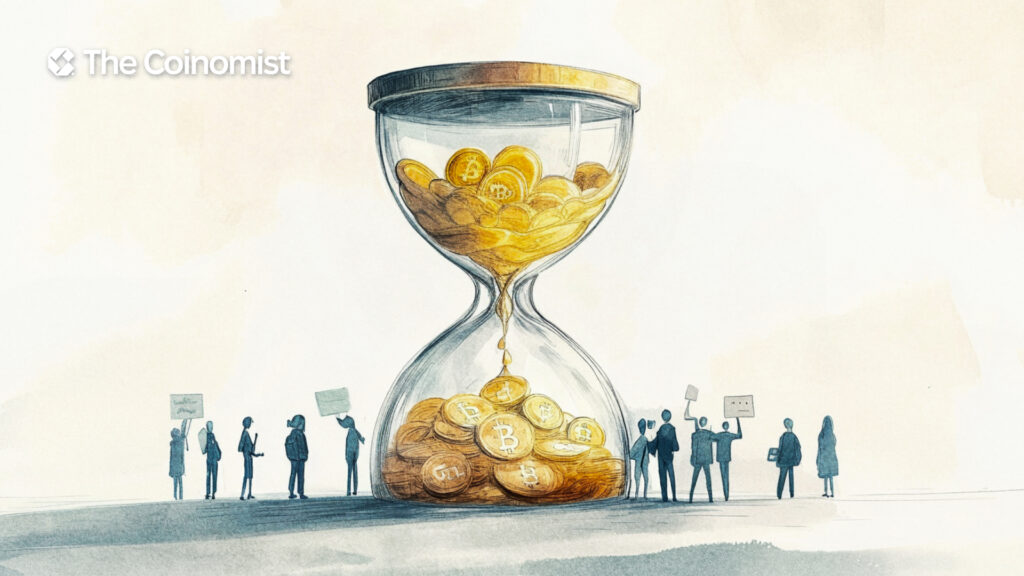What Happens When Bitcoin Runs Out? Predictions and Strategies

Explore what happens when Bitcoin reaches its 21 million supply cap. Learn how the shift from block rewards to transaction fees could impact miners, investors, and the entire ecosystem.
On this page
- The Bitcoin Supply Model: Understanding the Cap
- The Impact of Bitcoin Reaching Its Supply Cap
- 1. Decreased Miner Rewards and the Role of Transaction Fees
- 2. Bitcoin’s Store of Value Potential
- 3. Bitcoin’s Role as a Medium of Exchange
- Predictions for Bitcoin’s Future Post-Supply Cap
- 1. Increased Demand and Higher Prices
- 2. Dominance of Bitcoin Over Other Cryptocurrencies
- 3. Innovations in Bitcoin Usage and Infrastructure
- 4. Global Economic Impact
- Strategies for Bitcoin Investors and Users
- 1. Diversifying Investment Portfolio
- 2. Embracing Layer 2 Solutions
- 3. Staying Informed on Regulatory Developments
- 4. Long-Term Holding (HODLing)
- Frequently Asked Questions (FAQs)
- What happens when Bitcoin runs out of supply?
- What year will Bitcoin run out?
- Can Bitcoin go to 0?
- What happens if Bitcoin collapses?
Bitcoin, the pioneering cryptocurrency, has been a revolutionary force in the financial world since its inception in 2009. With its decentralized nature, limited supply, and a promise to create a new financial system, Bitcoin has attracted millions of investors, miners, and enthusiasts worldwide. But what happens when Bitcoin runs out of supply? As the total supply is capped at 21 million BTC, this question becomes increasingly pertinent as the years pass. In this article, we will dive deep into the future of Bitcoin once its supply runs out, exploring potential predictions and strategies for the global economy, Bitcoin holders, and the cryptocurrency ecosystem as a whole.
The Bitcoin Supply Model: Understanding the Cap
To understand what might happen when Bitcoin runs out, it's essential to first comprehend how its supply model works. Bitcoin’s creator, Satoshi Nakamoto, designed the cryptocurrency to have a fixed supply of 21 million coins. This was done to mimic precious metals like gold, which are scarce and cannot be infinitely mined. The fixed supply of Bitcoin is one of its most critical features and a core principle of its value proposition.
New Bitcoins are introduced into circulation through a process called mining. Miners use powerful computers to solve complex mathematical problems that validate transactions on the Bitcoin network. In return, they are rewarded with newly minted Bitcoin. Initially, the reward for mining a block was 50 BTC, but this reward is halved approximately every four years in an event called the “halving.”
The halving will continue until the final Bitcoin is mined, which is expected to happen around the year 2140. After this point, no new Bitcoin will be created, and miners will be compensated only through transaction fees. This fixed supply and decreasing rate of new Bitcoin entering circulation have far-reaching implications for the future of Bitcoin and its price.
The Impact of Bitcoin Reaching Its Supply Cap
As Bitcoin nears its supply cap of 21 million, several key questions arise regarding its future. How will the market react when Bitcoin reaches this point? Will it still retain its value? What strategies should investors and users adopt to adapt to this new phase in Bitcoin’s evolution?
1. Decreased Miner Rewards and the Role of Transaction Fees
Currently, miners are incentivized to mine Bitcoin blocks not only by the block rewards but also by transaction fees. However, as the block reward continues to decrease with each halving, transaction fees will play an increasingly vital role in securing the network.
When Bitcoin reaches its supply cap, miners will no longer receive new Bitcoin as a reward. Instead, their income will depend entirely on transaction fees paid by users who wish to send Bitcoin. This means that, for the network to remain secure, transaction fees must rise to provide sufficient compensation to miners for maintaining the Bitcoin blockchain. The success of Bitcoin as a payment system, especially in terms of scalability, may hinge on whether transaction fees can sustain the network's security at that point.
2. Bitcoin’s Store of Value Potential
Bitcoin's capped supply has contributed to its designation as a store of value, akin to gold. As the supply limit is approached, Bitcoin’s value may rise even further, primarily due to scarcity. Just as gold has been valued throughout human history for its limited availability, Bitcoin may gain more appeal as a deflationary asset.
Many experts believe that as the total supply nears 21 million, Bitcoin could become even more attractive to institutional investors and individuals looking for a hedge against inflation or economic instability. If Bitcoin continues to be seen as a store of value, it could increasingly displace traditional assets like gold, stocks, and bonds in some portfolios, especially as fiat currencies suffer from inflation or currency devaluation.
3. Bitcoin’s Role as a Medium of Exchange
While Bitcoin is often hailed as a store of value, its original vision was as a medium of exchange. However, as the supply limit approaches and transaction fees increase, Bitcoin may face challenges in this area. Higher transaction fees could make it more expensive for users to send small amounts of Bitcoin, making it less practical for everyday transactions.
That said, second-layer solutions like the Lightning Network aim to address scalability and reduce fees by creating faster, off-chain transactions. If these solutions continue to gain adoption, Bitcoin could still serve as a global medium of exchange, even after its supply is exhausted.
Predictions for Bitcoin’s Future Post-Supply Cap
As Bitcoin approaches its supply cap, the following predictions offer insight into the future of the cryptocurrency.
1. Increased Demand and Higher Prices
Many experts predict that as the final Bitcoin is mined, demand for the digital asset will continue to rise, potentially driving its price to new all-time highs. With a fixed supply and increasing demand from institutional investors, Bitcoin could experience significant price appreciation. This scarcity-driven price rise could be compounded by its increasing recognition as a store of value and a hedge against inflation.
2. Dominance of Bitcoin Over Other Cryptocurrencies
Bitcoin is already the most valuable cryptocurrency by market capitalization, and its position as the leader in the space could solidify even further as the total supply reaches its cap. As the supply of Bitcoin becomes more finite, other cryptocurrencies may struggle to match its level of security and trustworthiness. Bitcoin's position as the “gold standard” in the crypto world may lead to even greater dominance in the global financial landscape.
3. Innovations in Bitcoin Usage and Infrastructure
As Bitcoin matures, its ecosystem is expected to evolve in ways that maximize its utility. The development of technologies like the Lightning Network and advancements in blockchain interoperability will likely make Bitcoin more efficient for both payments and investment. Furthermore, regulatory clarity will play a significant role in Bitcoin's future, as governments around the world develop frameworks to integrate Bitcoin and other cryptocurrencies into the global financial system.
4. Global Economic Impact
Bitcoin’s limited supply may prompt significant shifts in the global economy. With more people and institutions adopting Bitcoin as a store of value or medium of exchange, it could challenge the dominance of fiat currencies and the global banking system. Countries facing hyperinflation or political instability may adopt Bitcoin as an alternative currency, further pushing its adoption and price. Conversely, governments could respond with stricter regulations, which might impact the wider adoption and usage of Bitcoin.
Strategies for Bitcoin Investors and Users
As Bitcoin approaches its supply cap, investors and users need to consider strategies for safeguarding their assets and adapting to new economic realities. The following strategies can help individuals and businesses navigate Bitcoin’s future:
1. Diversifying Investment Portfolio
For investors holding Bitcoin, it’s essential to diversify across multiple assets to minimize risk. While Bitcoin may continue to appreciate in value, it’s wise to hold a balanced portfolio of cryptocurrencies, stocks, bonds, and other assets to mitigate potential volatility in the market. Diversifying can help protect wealth against market downturns and sudden shifts in Bitcoin’s value.
2. Embracing Layer 2 Solutions
Bitcoin’s scalability challenges could be mitigated through the use of second-layer solutions like the Lightning Network. These technologies aim to process off-chain transactions, reducing fees and transaction times. As Bitcoin’s supply runs out and transaction fees rise, adopting these solutions will become increasingly important for businesses and individuals seeking to use Bitcoin for everyday transactions.
3. Staying Informed on Regulatory Developments
The regulatory landscape for Bitcoin will play a crucial role in shaping its future. Investors, businesses, and users need to stay informed about developments in cryptocurrency regulation, particularly as Bitcoin becomes more widely adopted. Keeping an eye on potential regulatory changes will help individuals prepare for shifts in the market and adjust their strategies accordingly.
4. Long-Term Holding (HODLing)
Many Bitcoin investors have adopted a strategy known as “HODLing,” which involves holding Bitcoin for the long term rather than selling in response to short-term price fluctuations. As Bitcoin’s supply nears its cap, HODLing could become an increasingly attractive strategy, as scarcity and demand push the price higher over time. However, it’s essential to have a clear understanding of one’s investment goals and risk tolerance before committing to this strategy.
In conclusion, the question of what happens when Bitcoin runs out of supply is complex, but it is clear that Bitcoin’s future remains bright, despite potential challenges. With a fixed supply, the cryptocurrency’s value may continue to rise, and innovative solutions will be necessary to ensure its continued relevance in the global economy. Investors, businesses, and users alike will need to adapt and be strategic as they navigate Bitcoin’s evolution.
Frequently Asked Questions (FAQs)
What happens when Bitcoin runs out of supply?
When Bitcoin reaches its supply cap of 21 million coins, no new Bitcoin will be mined. Miners will no longer receive block rewards but will be compensated through transaction fees. This shift may lead to higher transaction fees as the network’s security relies on miner incentives.
What year will Bitcoin run out?
Bitcoin is projected to reach its supply cap around the year 2140. After that point, no new Bitcoin will be mined, and the network will be maintained solely through transaction fees.
Can Bitcoin go to 0?
While Bitcoin’s value could experience significant volatility, it is unlikely to reach a value of 0. As a decentralized, digital asset with a fixed supply, Bitcoin has established itself as a store of value and has a strong community and institutional support.
What happens if Bitcoin collapses?
If Bitcoin were to collapse, it could result in a loss of value for those holding it. However, due to its decentralized nature and growing institutional adoption, a complete collapse seems unlikely. If Bitcoin faces significant challenges, alternative cryptocurrencies and blockchain technologies may rise to prominence.
The content on The Coinomist is for informational purposes only and should not be interpreted as financial advice. While we strive to provide accurate and up-to-date information, we do not guarantee the accuracy, completeness, or reliability of any content. Neither we accept liability for any errors or omissions in the information provided or for any financial losses incurred as a result of relying on this information. Actions based on this content are at your own risk. Always do your own research and consult a professional. See our Terms, Privacy Policy, and Disclaimers for more details.




















